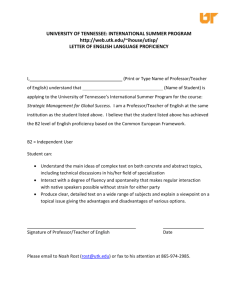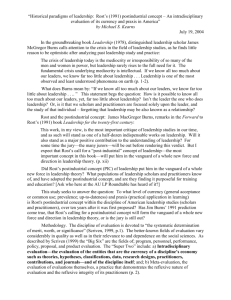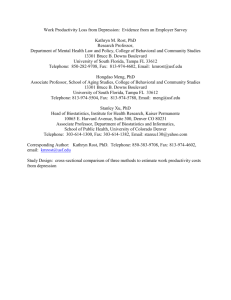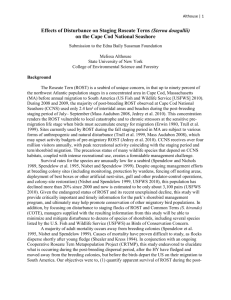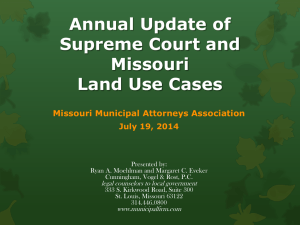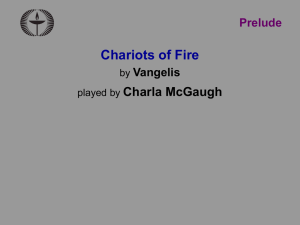March 2003
advertisement
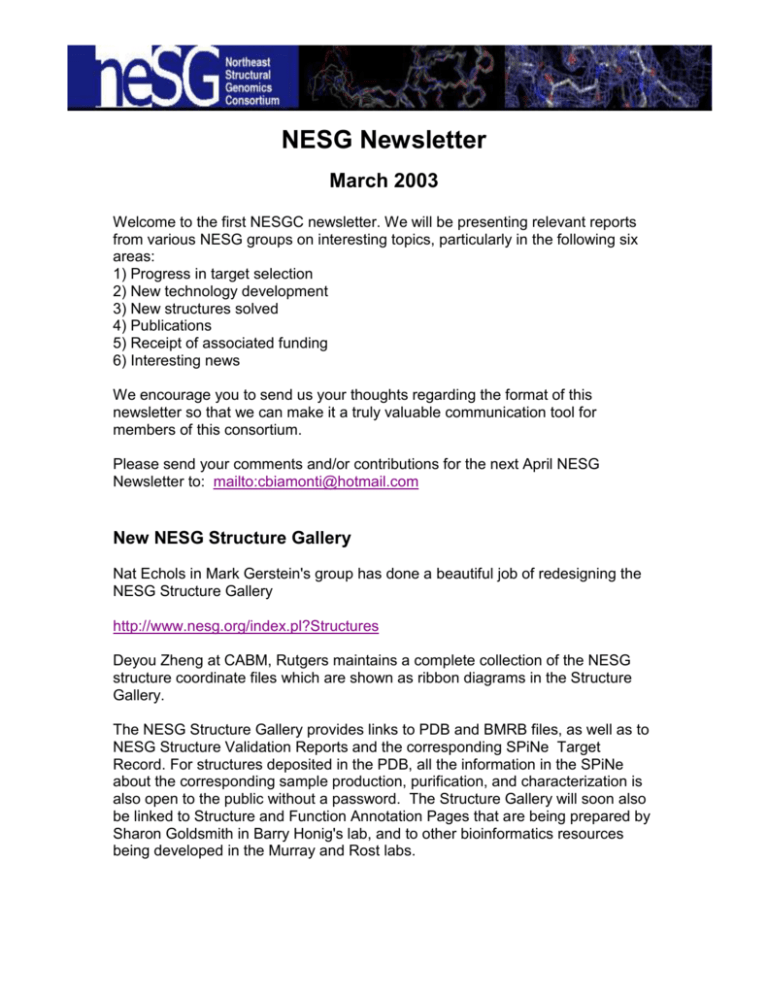
NESG Newsletter March 2003 Welcome to the first NESGC newsletter. We will be presenting relevant reports from various NESG groups on interesting topics, particularly in the following six areas: 1) Progress in target selection 2) New technology development 3) New structures solved 4) Publications 5) Receipt of associated funding 6) Interesting news We encourage you to send us your thoughts regarding the format of this newsletter so that we can make it a truly valuable communication tool for members of this consortium. Please send your comments and/or contributions for the next April NESG Newsletter to: mailto:cbiamonti@hotmail.com New NESG Structure Gallery Nat Echols in Mark Gerstein's group has done a beautiful job of redesigning the NESG Structure Gallery http://www.nesg.org/index.pl?Structures Deyou Zheng at CABM, Rutgers maintains a complete collection of the NESG structure coordinate files which are shown as ribbon diagrams in the Structure Gallery. The NESG Structure Gallery provides links to PDB and BMRB files, as well as to NESG Structure Validation Reports and the corresponding SPiNe Target Record. For structures deposited in the PDB, all the information in the SPiNe about the corresponding sample production, purification, and characterization is also open to the public without a password. The Structure Gallery will soon also be linked to Structure and Function Annotation Pages that are being prepared by Sharon Goldsmith in Barry Honig's lab, and to other bioinformatics resources being developed in the Murray and Rost labs. PSI Advisory Committee Recommends Supplemental Funding for Functional Studies The report of the PSI Advisory Committee (PSIAC) on the Nov. 14-15 Executive Meeting at NIH has been posted on the NIGMS web site at http://www.nigms.nih.gov/news/reports/psi_advisory02.html The report summarizes the recommendations of the PSIAC in several areas, including: 1. Better Communication with Scientific Community 2. Laboratory Information Management 3. Structure vs. Function 4. How Many Production Groups in Next Phase of PSI 5. Ongoing Technology Developments Some key conclusions of the report are: - Supplemental funding (up to $50K per collaboration) is now available for followon studies of biochemical function. Contact G. Montelione for details. - LIMS are viewed as critical to the infrastructure for these projects. - Although the plans for the next phase of the PSI are not yet disclosed, it will include significant support for continued technology development. Eleven NESG Structures Submitted to PDB In February According to SPINE, there are now 39 NMR structures and 32 X-ray crystals structures determinate by the NESG Consortium. Of these 71 structures, 64 have been submitted to the PDB. In 2003, 15 structures have been submitted to the PDB. The following eleven protein structures were submitted by the NESG Consortium to the PDB in February 2003: YTYst425 TT87 ER82 ER115 IR73 SR127 JR19 OP3 QR6 GR2 IR63 New Eukaryotic NESG Target Proteins Jinfeng Liu and Burkhard Rost recently provided an additional set of some 2240 full length protein targets from Arabidopsis thaliana, which have been entered in ZebaView and SpiNe. These are now in production together with our other eukaryotic targets: Caenorhabditis elegans: 337 Drosophila melanogaster: 252 Homo sapiens: 2839 Saccharomyces cerevisiae: 583 In addition, there are some 3000 prokaryotic protein targets. Progress Report from John Cort, PNNL Target selection: QR62 buffer being optimized by Yiwen Chang and Rajan at Rutgers. Two new samples, ZR31 or HR319 has been chosen for isotope enrichment and structure analysis by NMR. New structures solved: NESG target OP3, Vibrio cholerae protein VC0424 has been submitted to the PDB (1NXI, 2/10/03). NESG target YTYst425. This structure is a new fold. Also the protein is unique to S. cerevisiae, except for a moderately similar homolog in S. pombe. Structural statistics are provided in accompanying Excel spreadsheet, nesg_march03_structures. Collaborations: We are collaborating with Sharon Goldsmith in Barry Honig’s lab to perform the structural and functional analysis of VC0424. Some of her analysis is available at: http://trantor.bioc.columbia.edu/sharon/Target_list_1.html (use the spine login and password). These structural and functional annotation will soon be linked to SPiNe and to the NESG Structure Gallery. Sharon has done analysis with ConSurf and comparisons with ACT and RAM domains which have similar folds and known active site residues. VC0424 does not appear to be related to these domains. Janet Huang at Rutgers was extremely helpful in performing AutoStructure calculations on VC0424. We used AutoStructure and our preliminary structure along with manually-derived restraints to find over 160 new medium and long range restraints. We then used these in the X-PLOR calculation using the XplorNIH software. Publications: “Solution structure of the yeast ubiquitin-like modifier protein Hub1”, T.A. Ramelot, J.R. Cort, A.A. Yee, A. Semesi, A.M. Edwards, C.H. Arrowsmith, M.A, Kennedy, 2003, J. Struct. Funct. Genom., in press. Progress in Robotic Crystal Mounting This project is directed by Prof. Peter Allen at Columbia and is aimed at using computer vision and robotic grasping to mount protein crystals automatically. Computer Vision can provide rich knowledge about the spatial arrangement of objects to be manipulated as well as knowledge about the means of manipulation, which in our case are the instruments needed to perform crystal mounting. Our goal is to visually monitor and control these instruments as they isolate and mount protein crystals. We have developed an integrated visual control system, consisting of a high-resolution optical microscope, digital imaging system, image based servo-controllers and a micromanipulator that is able to precisely position a grasping loop with respect to a protein. The visual tracking algorithms use uncalibrated methods, making the system simple to use and robust. Once a crystal is acquired in an image, the tracking system can position the grasping loop to within 1 pixel of the centroid of the crystal, which corresponds to a positioning accuracy of .1 micrometers (Mezouar & Allen, 2002). We are currently investigating more advanced grippers, including silicon micro-machined tweezers, to pick up the crystals automatically. Mezouar, Youcef and Peter K. Allen Visual servoed micropositioning for protein manipulation, Int. Conf. Intelligent Robots and Sytems (IROS 2002), Lausanne, Switzerland, Oct. 1-3, 2002. Columbia Crystallography Group Completes Seven New Crystal Structures The following structures have been solved by X-ray crystallography and statistics are provided in the accompanying Excel file, nesg_march03_structures: ER82 ER24 IR73 ER13 SR127 IR63 SR144 Recent Publications by Burkhard Rost Bioinformatics Group, Columbia University 1. J Liu & B Rost (2002) Target space for structural genomics revisited. Bioinformatics, 18, 922-933. 2. CP Chen, A Kernytsky & B Rost (2002) Transmembrane helix predictions revisited. Prot Science 11, 2774-2791. 3. CP Chen & B Rost (2002) Long membrane helices and short loops predicted less accurately. Prot Science 11, 2766-2773. 4. R Nair & B Rost (2002) Sequence conserved for sub-cellular localization. Prot Science 11, 2836-2847. 5. Y Ofran & B Rost (2003) Analysing six types of protein-protein interfaces. J Mol Biol 325, 377-387. 6. CAF Andersen & B Rost (2003) Automatic secondary structure assignment. In 'Structural bioinformatics' P Bourne & H Weissig (eds.), John Wiley, 339-361. 7. B Rost (2003) Prediction in 1D: secondary structure, transmembrane helices and accessibility. In 'Structural bioinformatics' P Bourne & H Weissig (eds.), John Wiley, 557-585. 8. P Carter, J Liu & B Rost (2003) PEP: Predictions for entire proteomes. Nucl Acids Res 31, 410-413. 9. R Nair, P Carter & B Rost (2003) NLSdb: database of nuclear localization signals. Nucl Acids Res 31, 397-399. 10. J Liu & B Rost (2003) Domains, motifs, and clusters in the protein universe. Curr Opin Chem Biol 7, 5-11. 11. B Rost (2003) Rising accuracy of protein secondary structure prediction. In 'Protein structure determination, analysis, and modeling for drug discovery', D Chasman (ed.), Dekker, New York, 207-249. Publications in press 12. B Rost (2003) Neural networks predict protein structure: hype or hit? In 'Artificial intelligence and heuristic methods for bioinformatics' P Frasconi (ed.), IOS Press, in press. 13. R Zidovetzki, B Rost, Don L Armstrong & I Pecht (2002) Transmembrane domains in the functions of Fc receptors. J Biophysical Chemistry in press. 14. KO Wrzeszczynski & B Rost (2003) Cataloguing proteins in cell cycle control. In 'Cell cycle checkpoint control protocols' H Lieberman (ed.). 15. B Rost, J Liu, D Przybylski, R Nair, H Bigelow, K Wrzeszczynski & Y Ofran (2003) Predicting protein structure through evolution. In 'Chemoinformatics From Data to Knowledge' J Gasteiger & T Engel (eds.), Wiley.
